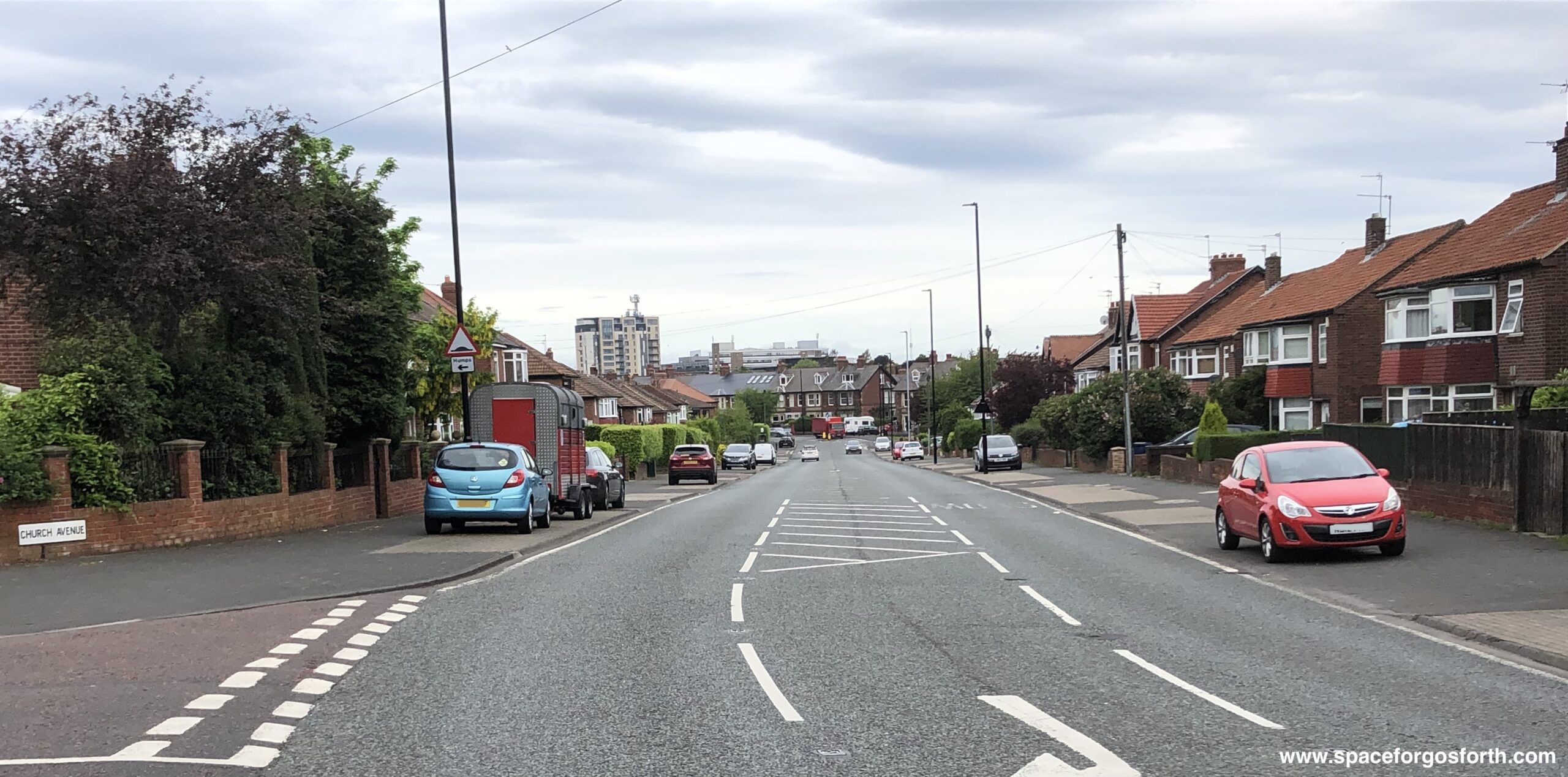
Church Avenue, Gosforth, just west of Station Road
Newcastle City Council confirmed in February, following an eighteen-month trial and six-month consultation, that the arrangements at Stoneyhurst, Dene and Salters Bridges would be made permanent to help make local streets safer, cut carbon emissions from driving and promote active travel.
The map below shows the location of Salters and Stoneyhurst Road bridges and average annual daily traffic levels on Station Road between 2013 and 2021. Both bridges were closed to motor traffic in August 2020. Salters Bridge was previously closed to traffic during the Killingworth Road roadworks between July 2017 and October 2019.
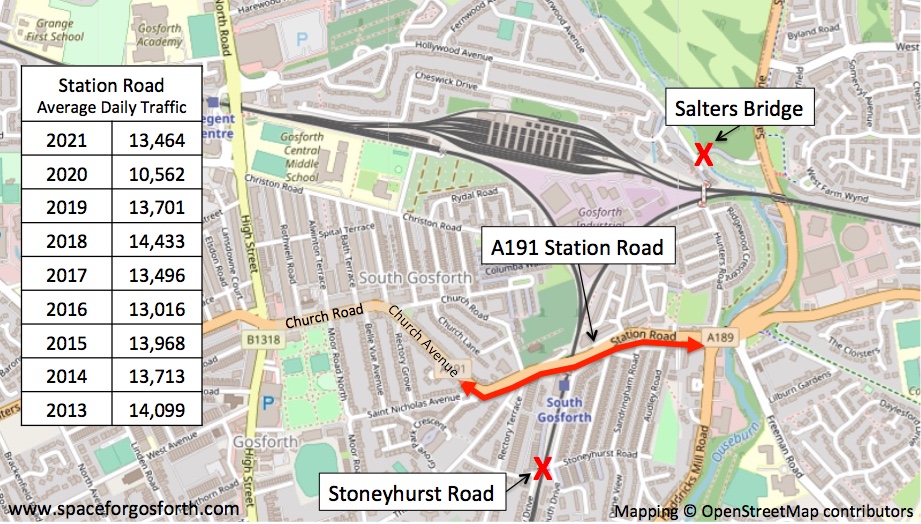
Station Road traffic count shows 2021 was lower than all years other than 2016 and 2020.
One of the main concerns raised by people responding to the Council consultation was that (they believed) these closures would lead to “displaced traffic / congestion”. We now have nineteen months of traffic data since August 2020 that shows traffic levels on Station Road and Sandy Lane (north of Gosforth Racecourse) are broadly unchanged from previous years.
Station Road and Sandy Lane are neither busier nor more congested following closure of the bridges. Meanwhile Hollywood Avenue and Stoneyhurst Road have much less traffic.
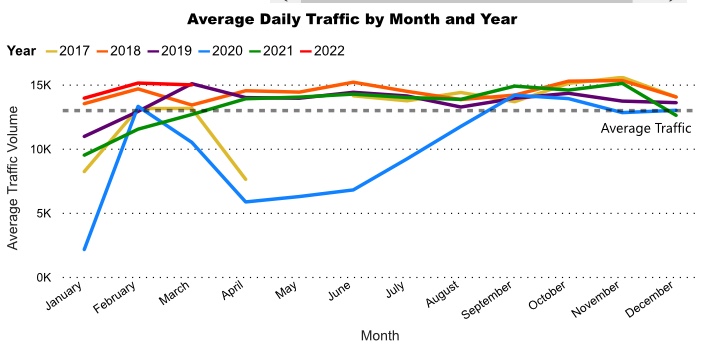
Traffic Volumes on Station Road, measured 30m west of Bowsden Terrace
This is one reason why the Council could “set aside” any objections due to displaced traffic, as there simply isn’t any evidence of additional traffic on adjacent main roads. The Council needs to share this information so people commenting on future LTN consultations better understand the likely impact on traffic in their local area.
Even if traffic levels had increased on Station Road (which didn’t happen), there still wouldn’t be a good case for using Stoneyhurst Road or Hollywood Avenue as overflows for ‘displaced’ main-road traffic, as these minor roads are neither intended nor designed for high levels of vehicle traffic.
Despite this, the Council was still (in our view unfairly) accused of “ignoring” residents’ views. Clearly there is still a need for education so that people more widely understand how traffic reacts (and has reacted) to road changes. Local Councillors and community groups could help with this, and reduce community tensions, by sharing facts and relevant information in local leaflets.
This effect of “disappearing traffic” is well known and understood by traffic professionals. Researchers looking at over 70 case studies found that “predictions of traffic problems are often unnecessarily alarmist, and that, given appropriate local circumstances, significant reductions in overall traffic levels can occur, with people making a far wider range of behavioural responses than has traditionally been assumed.“
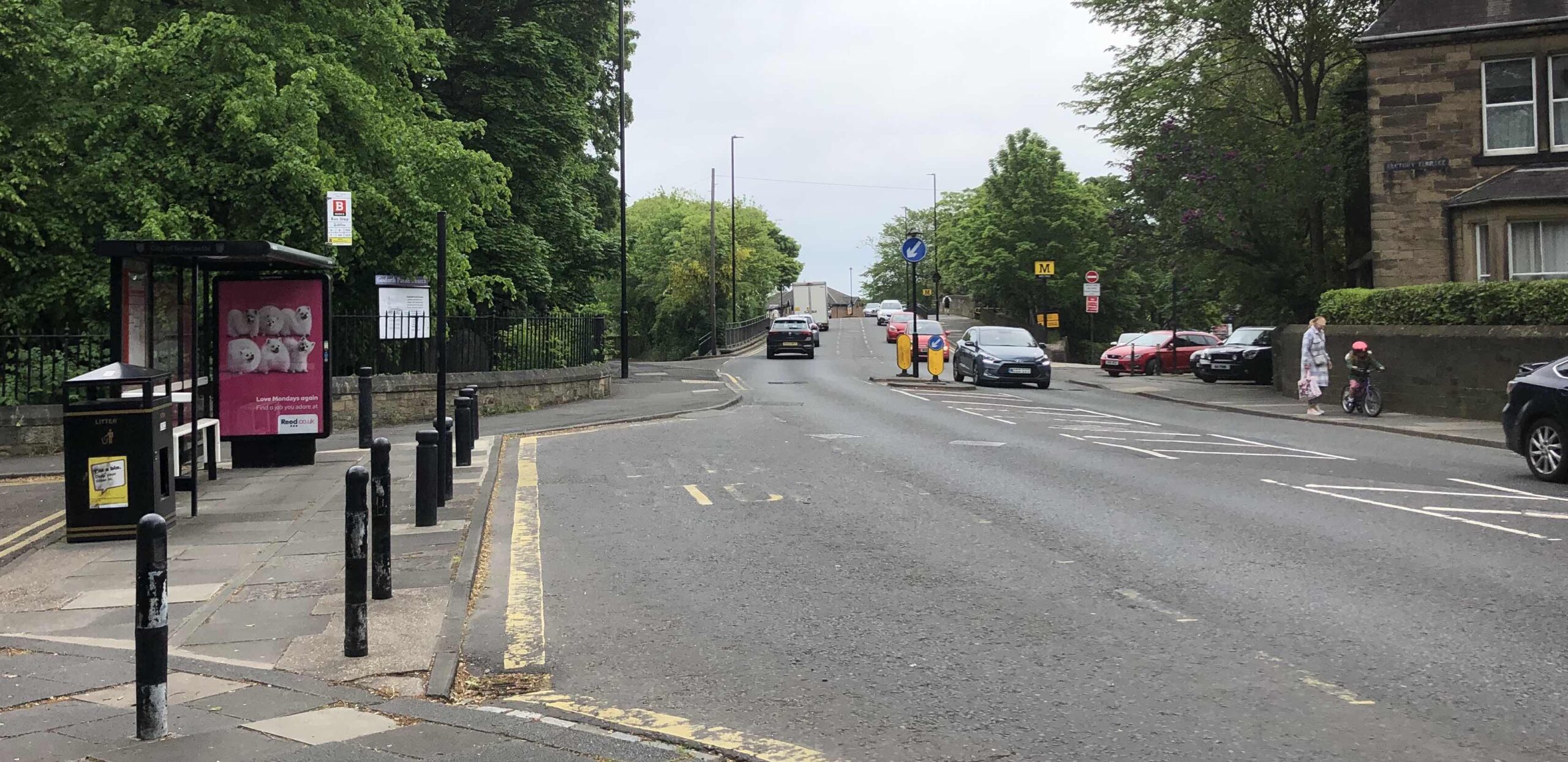
Station Road looking towards South Gosforth Metro with longstanding “modal filter” at the end of Church Road
While the traffic levels on Station Road will have benefited from more home-working and people travelling less due to fuel costs, the study shows that “disappearing traffic” would happen even without these.
We can conclude that the bridge closures have helped to reduce traffic levels locally in Gosforth and have contributed towards the necessary 20-50% reduction in miles driven by 2030 to help achieve net zero targets.
That doesn’t mean that traffic levels on Station Road are ok. Just like before 2019, it still has high levels of traffic making it hard to cross and dangerous to cycle. These could be mitigated, for example with additional crossings and protected cycle lanes. The east end of Station Road is also part of the South Gosforth Air Quality Management Area and in 2016, before Killingworth Road roadworks, pollution measurements exceeded the legal limit.
If you live on the A191 – Church Road, Church Avenue or Station Road, or other main roads around Gosforth – please let us know what you think could be done to cut traffic and/or make the road safer.
Further information is provided below about feedback to Newcastle City Council’s Stoneyhurst Road and Salters Bridge consultations, and on traffic levels on Station Road and Sandy Lane.
Stoneyhurst Bridge closure: main themes from ETRO correspondence
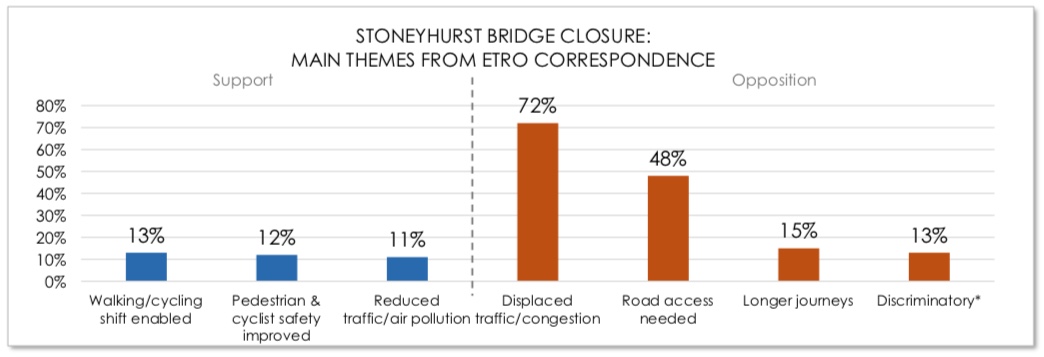
Main feedback themes – Support
- Walking / cycling shift enabled – 13% of responses*
- Pedestrian and cyclist safety improved – 12%
- Reduced traffic / air pollution – 11%
Main feedback themes – Opposition
- Displaced traffic / congestion – 72% of responses*
- Road access needed – 48%
- Longer journeys – 15%
- Discriminatory – 13%
* NB there was no geographical restriction on who could respond, nor any limit on the number of responses per person.
As we have said, traffic levels on Station Road and Sandy Lane did not increase. Road access for vehicles was retained to all properties. We have also previously looked at journey lengths and our analysis was that very few journeys would be noticeably longer as a result of this change.
The Council’s Integrated Impact Assessment says “data does not indicate an impact on the operation of the wider highway network from any of the bridge closures to vehicles to indicate that they need to be reopened to alleviate this issue. Despite having been closed, (even when three bridges impact on the same surrounding highways), those highways have not seen significant differences in journey times or speeds.“
The fact that traffic in Newcastle grew by 14% between 2010 and 2019, which has never been the subject of consultation, is much more likely to have negatively impacted journey times.
Salters Bridge closure: main themes from ETRO correspondence
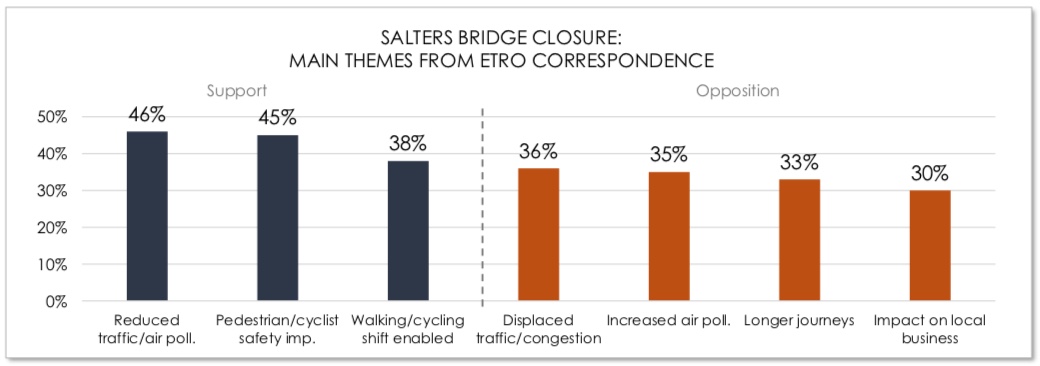
Main feedback themes – Support
- Reduced traffic / air pollution – 46% of responses
- Pedestrian and cyclist safety improved – 45%
- Walking / cycling shift enabled – 38%
Main feedback themes – Opposition
- Displaced traffic / congestion – 36% of responses
- Increased air pollution – 35%
- Longer journeys – 33%
- Impact on local businesses – 30%
As there is no additional traffic, there is no reason to think air pollution will be any worse on Station Road as a result of these changes. There is substantial evidence that investing in active travel benefits local businesses, for example this report from Transport for London or our blog Can protected cycle lanes be good for business?
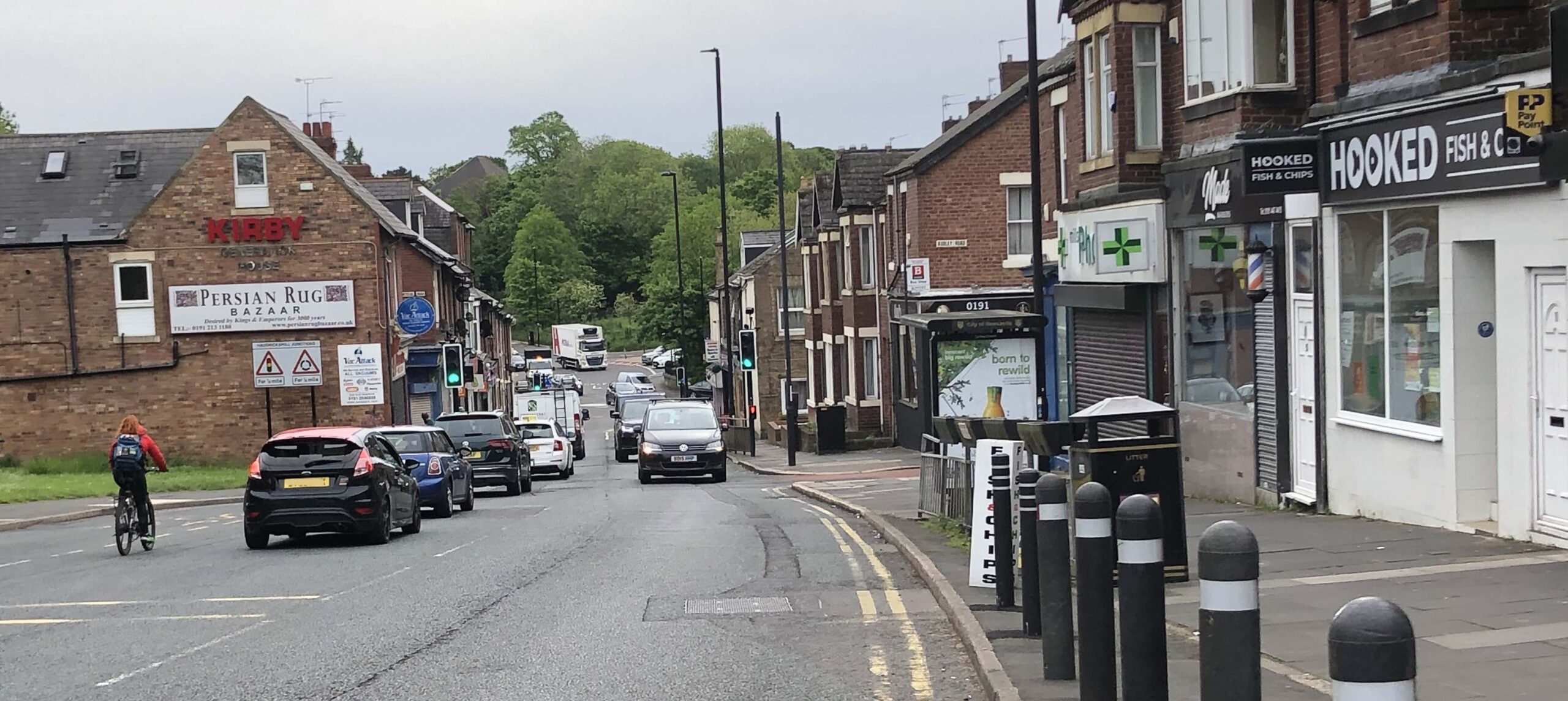
Station Road, looking towards Haddricks Mill
Traffic Volumes – Station Road

Traffic Volumes on A191 Station Road, Gosforth, measured 30m west of Bowsden Terrace
The graph above shows that traffic volumes in 2021 and 2022 are largely unchanged compared to 2018 and 2019. These traffic volumes are also largely unchanged from 2013-2017.
Traffic Volumes – Sandy Lane
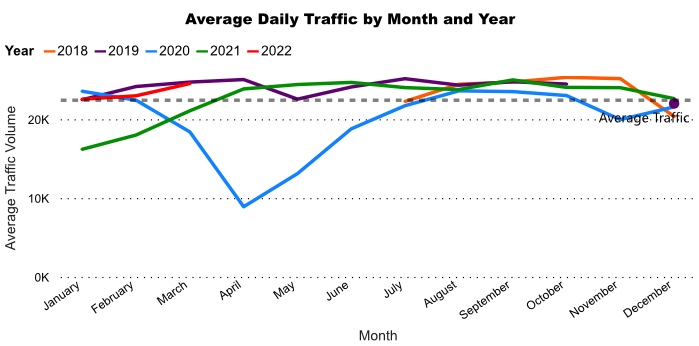
Traffic Volumes on A1056 Sandy Lane, Gosforth, measured east of the MOT station.
Traffic on Sandy Lane in 2021 and 2022 is also unchanged from 2018 and 2019.
Reports setting out the Council’s decisions for each of the five bridges are published here:
- Argyle St – https://democracy.newcastle.gov.uk/ieDecisionDetails.aspx?ID=10801
- Haldane – https://democracy.newcastle.gov.uk/ieDecisionDetails.aspx?ID=10799
- Dene Bridge / Castle Farm Rd – https://democracy.newcastle.gov.uk/ieDecisionDetails.aspx?ID=10798
- Stoneyhurst – https://democracy.newcastle.gov.uk/ieDecisionDetails.aspx?ID=10802
- Salters Bridge- https://democracy.newcastle.gov.uk/ieDecisionDetails.aspx?ID=10800
Further information on low traffic neighbourhoods In Newcastle can be found at https://www.newcastle.gov.uk/neighbourhoods
https://twitter.com/SustransNorth/status/1527581684769644545

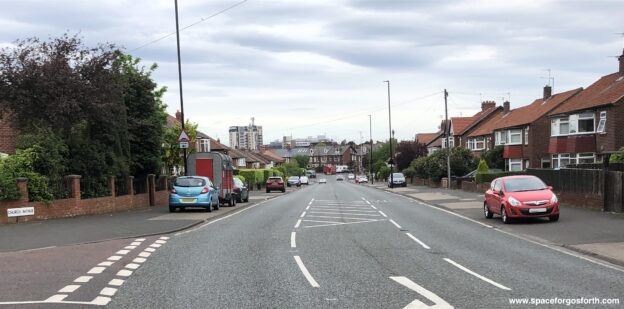
1. A resident of Windsor Tce who has to go to hospital twice weekly by taxi is paying significantly more for taxi fares because of the longer route and longer queues. He has evidence of this additional time and cost – route to RVI via ilford rd was shorter so cheaper. Parallel arguments by other residents who cite longer journey times into Newcastle – often those who have physical disabilities or limitations so must use the car. Active travel is not an option for them. These individuals have expressed their views both locally and direct to Grant Shapps but have not received responses nor do they feel that the needs of the minority have been given due weight. So there is a frustrated minority view which do not consider their specific needs to have been taken into account.
2. Congestion on Windsor Tce and Balmoral is considerably greater since closure of Stoneyhurst Bridge . Deliveries to South G school now have to use these roads or Dene Terrace. These roads have more parked cars – more home working and fewer people using the cars during the days which means that there is less road space for traffic to pass, all these roads are effectively wide enough now for only one vehicle – the side effect is slower traffic and safer conditions, however road rage is more common, and access for removals vehicles, deliveries, the school, recycling wagons is significantly more difficult.
3. Parking on Windsor terrace by those using the metro is now back to pre-pandemic levels. This is exacerbating congestion. As more people switch to hybrid and EV in these streets then charging in back lanes is the only available option – so when NCC said if we had residents parking there would have to be double yellow lines in back lanes this is now doubly not a viable option. However some mangement of the parking in these streets would mitigate the very localised congestion caused by the closure of Stoneyhurst.
4 active travel to the school has increased and the childrens cycling and walking to and from school is so much safer and enjoyable. This has to be a critically important benefit.
In summary
I am a firm supporter of the closure and have seen and experienced significant benefits, however those against it and who have incurred additional costs and delays as a consequence have a right to have the impacts they have experienced to be given due weight and acknowledged. And where possible measures taken to mitigate such impacts. Residents parking in Windsor Tce would go a long way towards this
I cross Station Road (by the metro) by bike to get to work, and I think there are longer queues on Station Road particularly Westbound compared to pre pandemic.
On the other hand, Killingworth Road seems to have much reduced levels of traffic.
I remember seeing council signs suggesting that Balmoral Tce be made one way – not sure what happened to that idea, but it would make sense to me (as a non resident) to have Balmoral Tce and Windsor Tce both one way but in opposite directions.
Fantastic to be able to cycle and walk with my kids around Stoneyhurst Road. Feels so much safer, much less stress and worry about them running out into the road. So much so that we’ve just bought a house there!